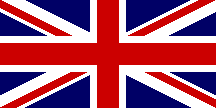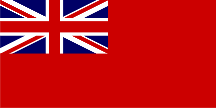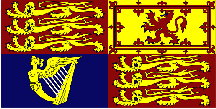|
First of all, the Union Jack is not, and never has been, a maritime ensign as the name might suggest. The issue of whether it is acceptable to use the term "Union Jack" is one that can cause considerable controversy since normally the term "jack" refers to a small flag flown at the bow of a ship. The British use of the traditional name "Union Jack" dates back to the early 1700s, when it became usual for the King's ships to hoist a small version of the Union Flag in their bows. The small Union Flag in the bow became known as the "Union jack-flag," which was later shortened to "Union Jack." Still later, when the Union Jack began to be put to other uses, the term "Union Jack" had been used so widely and for so long that the terms "Union Jack" and "Union Flag" became completely interchangeable. It should be noted that "Union Flag," is the term preferred in official documents by vexillologists.

Union Jack - Union Flag 1801
Traditionally, at sea the British national flag was any of the naval ensigns, of which there are three main types, the red, white and blue. There are versions of the blue and red flags with badges in the fly representing the member states and overseas territories of the Commonwealth. If the different badges are counted separately there are over one hundred British maritime national flags, but the actual "Union Jack" has never been considered one of these maritime flags. Strangely enough, it was another of the maritime ensigns that was first recognized by Parliament as a national flag in 1854.

Royal Navy Red Ensign 1801
The first of the naval ensign to be referred to as a national flag is the Red Ensign which was referred to as "a national flag" in an Act of Parliament in 1854. Then in 1889, an Act of Parliament was passed making it compulsory for British ships to fly the Red Ensign on certain occasions. This was fiercely opposed by the owners of coastal shipping, on the grounds that there was no need for a British ship to fly a flag in British waters. The Red Ensign is the only flag that has even been the subject of legislation.
The earliest official reference to the Union Jack as the national flag, found so far, is in the Army Regulations of 1873; which combined the words "...the national flag (Union Flag)...." The fact that they felt it necessary to combine them suggests that this was a relatively recent idea. The Union Jack was still theoretically a royal flag, but was in practice a government flag used on special occasions.
In 1886, the Prince of Wales (later Edward VII) in his capacity as Field Marshal and Commander-in-Chief wrote: "I am definitely against the anomaly of storehouses or store depots flying the National Flag." The Adjutant General, in passing on this ruling wrote; "We think that the use of these (National) flags should be limited to such places as fortresses, Headquarters, etc, where they may be held fitly to represent the centre of Imperial power at the place, and that it is absurd to allow them to be flown over storehouses where, if a flag is wanted at all, the ordinary distinguishing pennant would be more appropriate, and more useful." As a result of this ordnance depot flags were withdrawn and their flagstaffs dismantled.
The idea that the Union Jack was a royal flag came to an end when Queen Victoria died in 1901. At her death Edward, the Prince of Wales, became King Edward VII. At this time the Royal Standard was still considered to be the flag of the United Kingdom, and not just the personal Standard of the Sovereign. It was being used by members of the Royal Family; flown at certain military parades; displayed on fortresses and official buildings in the United Kingdom, and at Government Houses in the colonies. It was flown on royal anniversaries and flown on government buildings when the sovereign was passing in State. It was also flown by private individuals and organizations who thought that it was an appropriate way of displaying their loyalty to the crown. Apparently, Edward decided to try and clarify things. He wanted the royal standard to be used only as a personal standard and not as a government flag. To discourage its use by the general public, he made his royal wishes known by sending a "memo" to the Admiralty, War Office, Police Forces, and other governmental agencies requesting that the Royal Standard not be displayed on fortresses and official buildings unless the sovereign was actually present. Thus he hoped the Royal Standard would became the royal family flag and the Union Jack to become the government or national flag.

Royal Standard 1801
Edward's decision to restrict the use of the Royal Standard apparent confused his subjects about what was the correct Flag to be flown on land by civilians and in 1902, Sir Arthur Woods, who was the head of the College of Arms, provided a memorandum for the House of Commons to clarify the matter. His comments may now seems a little patronizing, but he was attempting to express the opinion of the College of Arms about about which flags should be display by civilians. Basically, the College felt that since most British flags had developed from banners of heraldic arms, which were granted only to those who had a title, then simply, no title, no coat-of-arms, no flag. He said:
"There is no Flag in existence answering to this general description. Civilians generally are not authorized to fly or display any Flag. Peers and gentlemen, entitled to bear Arms, have a right to fly from their Castles or residences a banner of their Arms. The Royal Standard appertains to the Sovereign alone. The Union Flag of the United Kingdom is used by authority throughout the Army and Navy, and the State Departments, usually with some modification or addition by way of distinction."
"The Union Flag, being the National Flag, appertains to the Nation as a whole, and cannot be considered as specially distinctive of individuals or groups of individuals."
"The common practice on occasions of national rejoicing of displaying the Royal Standard and the Union Flag indiscriminately with other Flags must be regarded as an attempt to express loyalty by means of decoration."
"As to Public Buildings, Schools, etc - State Buildings should fly the Union Flag. Schools etc., should fly the Flag displaying their proper Arms. Municipal Buildings should fly a banner of the Arms of the particular Corporate body. The issue of a Royal Warrant touching this matter [ie. To create an official national flag] would, in my opinion, be inexpedient."
Sir Arthur W. Woods, Garter, King of Arms, upon the question asked in the House of Commons on October 22, 1902.
|
However, the issue of civilian use of the Union Jack as a national flag was not dead. In answer to the same question in the House of Lords on July 14, 1908, the Earl of Crewe replied that "the Union Jack should be regarded as the national flag, and it undoubtedly may be flown on land by all His Majesty's subjects."
In reply to a parliamentary question on June 27, 1933, about whether private citizens were prevented from flying the Union Flag, the Home Secretary Sir John Gilmour said "No Sir, the Union Flag is the national flag and may properly be flown by any British subject on land."
Even with all this encouragement, the Union Jack was still perceived by many to be for government use only. In 1937, companies and public bodies were writing to the Home Office, or Colonial Office in the case overseas organizations, asking if they might have permission to fly the Union Jack on the day of George VI's coronation. In 1941, the flag of a colonial governor was changed in order to encourage use of the Union Jack in the colonies. When aboard ship Governors had a Union Jack with the badge of the colony in the centre, but on land they flew a plain Union Jack. Even at this late date, some people were reluctant to fly a Union Jack as they thought it was now the flag of the governor, and that to fly one themselves would be disrespectful.

Union Jack - Union Flag
Today, most British citizens seem comfortable with displaying the Union Jack as their "national" flag whenever they wish, even if Parliament has never officially passed a flag resolution making the Union Jack their national flag by legislation. On special occasions the Union Jack and the Royal Standard are both displayed to show their pride and love of country and their royal traditions.
Want More Information?
Visit: "The Journey from Maritime Ensign to National Flag"
"A Timeline for the Union Flag/Jack."
|